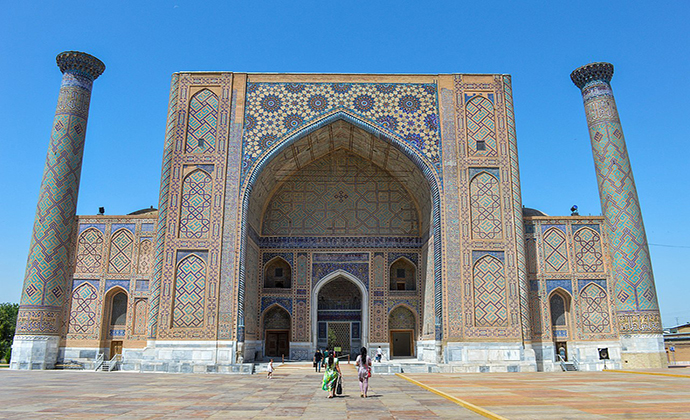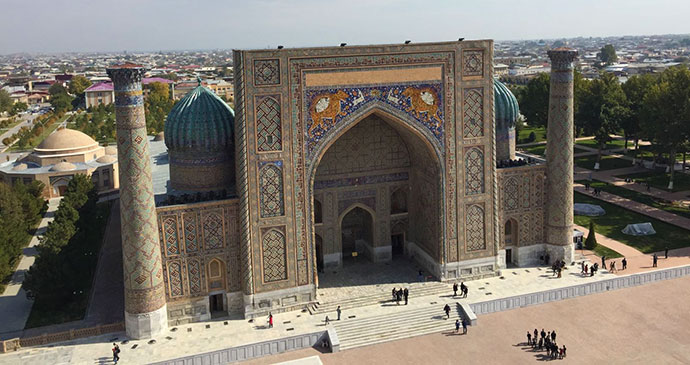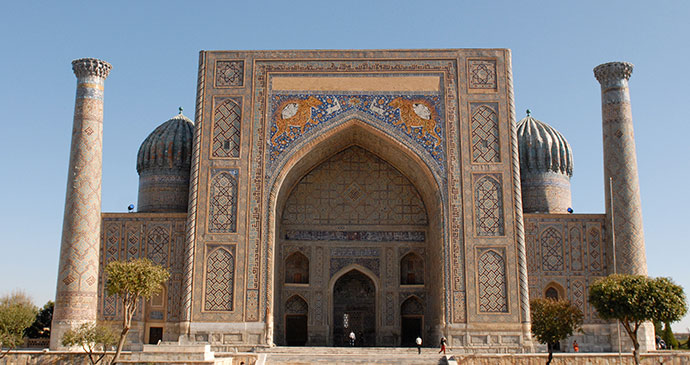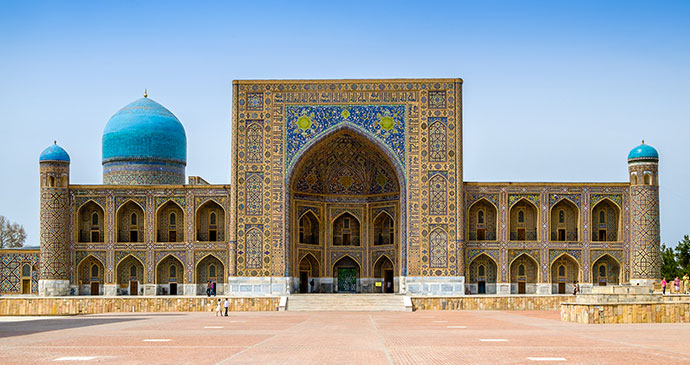Samarkand’s central square will make even the most architecture-weary visitor stand up and take note. Pausing for a minute (and a photo) on the raised viewing platform, the square unfolds below you. An almost infinite number of contrasting patterns swirl and dance on every surface but somehow never clash; the equally garishly patterned textiles worn by Uzbek women walking by appear almost as a continuation of the buildings themselves. The effect is completely mesmerising.

The Registan grew up around the tomb to the 9th-century saint Imam Muhammad ibn Djafar (the tomb can be found in front of the Sher Dor madrasa, but is barely noticeable nowadays), but by the 14th century this was also the commercial heart of the town. Six roads ran through the square, and it was connected directly with Timur’s citadel. Imperial decrees were shouted from the rooftops, and people would have gathered here to watch military pageants and other forms of spectacle. The three magnificent buildings you see today are the successors to this medieval centrepiece.
Ulug Beg Madrasa
The square was laid out by Timur’s grandson Ulug Beg, an intellectual who, sadly for his faltering empire, spent more of his time concentrating on maths and science than he did on affairs of state. He built the oldest madrasa, the Ulug Beg Madrasa, on the left of the square, between 1417 and 1420. His love of astronomy is shown in the mosaic tilework above the 15m arch on the main portico: it’s a depiction of the sky and the stars.

The madrasa itself measures 56m by 81m and is built around a large courtyard with a high blue-tiled portal on each side. At its peak, some 100 students lived in the 50 cells, many of them making use of the astronomical instruments housed here before the construction of Ulug Beg’s Observatory. Unusually, this was not a religious madrasa: students here studied mathematics and the sciences.

For an extra US$2.35 you can climb up the steep and narrow staircase to the top of the right-hand minaret, finally pulling yourself up through the metal hatch and on to the rooftop, 34m above the ground. There’s scarcely any room to move and you have to sit in a precarious position with an awfully long drop below, but if you can overcome any fear of heights, this is an exhilarating place from which to view the tiger mosaic on the Sher Dor Madrasa opposite and you feel like you’re on top of the world. The minaret of the Ulug Beg Madrasa was jacked up in 1922; it collapsed and was rebuilt, but it still has a clear tilt.
Sher Dor Madrasa
The Sher Dor Madrasa (the Tiger or Lion Madrasa), built between 1619 and 1636 by Yalangtush Biy, must be one of the most-photographed buildings in existence. There are two ribbed domes (best seen from inside rather than from the Registan Square) and two minarets flank the façade.

The elaborate mosaic work on the portico shows two sun gods, two strange big cats each with tiger’s stripes but a lion’s mane, and two deer, and must therefore contravene so many Islamic prohibitions on art. Despite this, it was a religious building. The mosaic was ravaged over time, but was heavily restored in the 20th century to the condition you see today. Restoration work is ongoing, so parts of the interior courtyard may well be under scaffolding.
Tilla Kari Madrasa
The third of the madrasas to be built, and the centrepiece of the square, was the Tilla Kari Madrasa (Gold-covered Madrasa). When the Bibi Khanym Mosque started to fall into disrepair in the mid 17th century, Yalangtush Biy decided a replacement was needed, so he commissioned this combined mosque-and-madrasa complex on the site of the ruined Mirzoi caravanserai. Construction was completed in 1660 after 14 years of hard work; the dome was reconstructed in the 20th century as the original had been destroyed by Nadir Shah’s forces in the early 18th century.

Though it is easy to get caught up looking at the exterior, this is the one madrasa you must go inside: the golden ceiling of the mosque, to the left of the courtyard, is utterly enthralling, and it is this gilt that gives the madrasa its name. Tour groups inevitably spend a while lingering here and blocking the view, but be patient and wait for space. Position yourself immediately beneath the centre of the golden dome and then look straight up to appreciate the full effect.
For more on Uzbekistan’s Silk Road gems, take a look at our guidebook:
